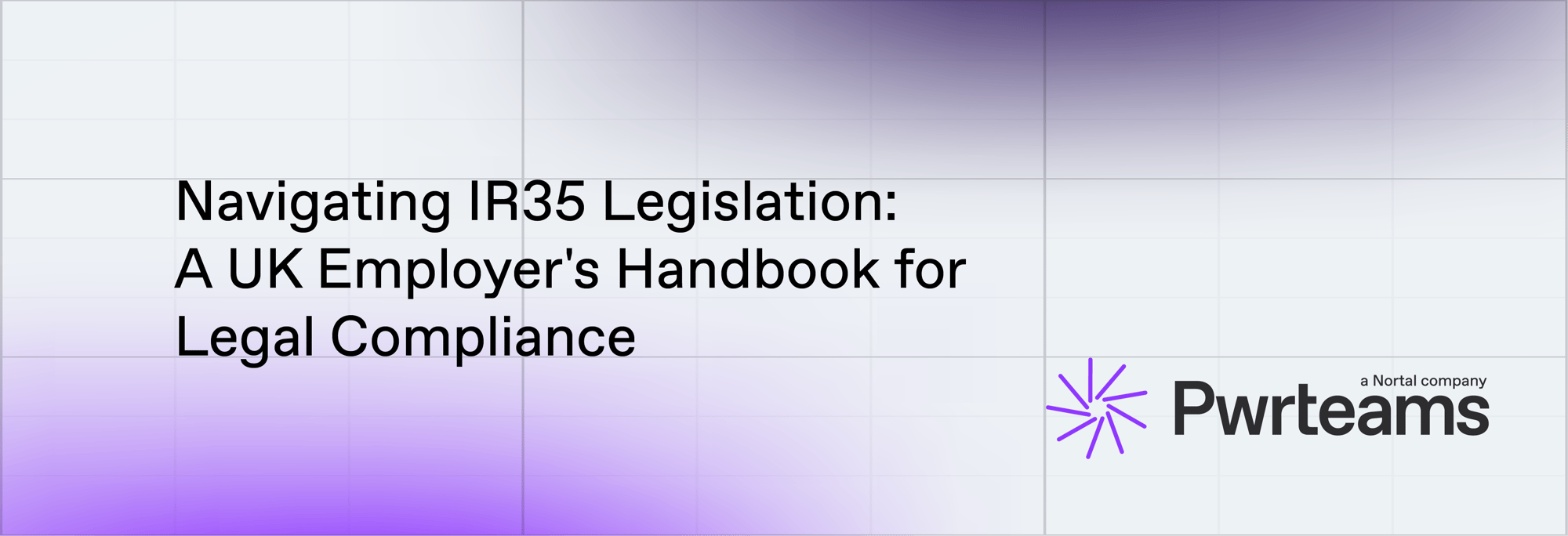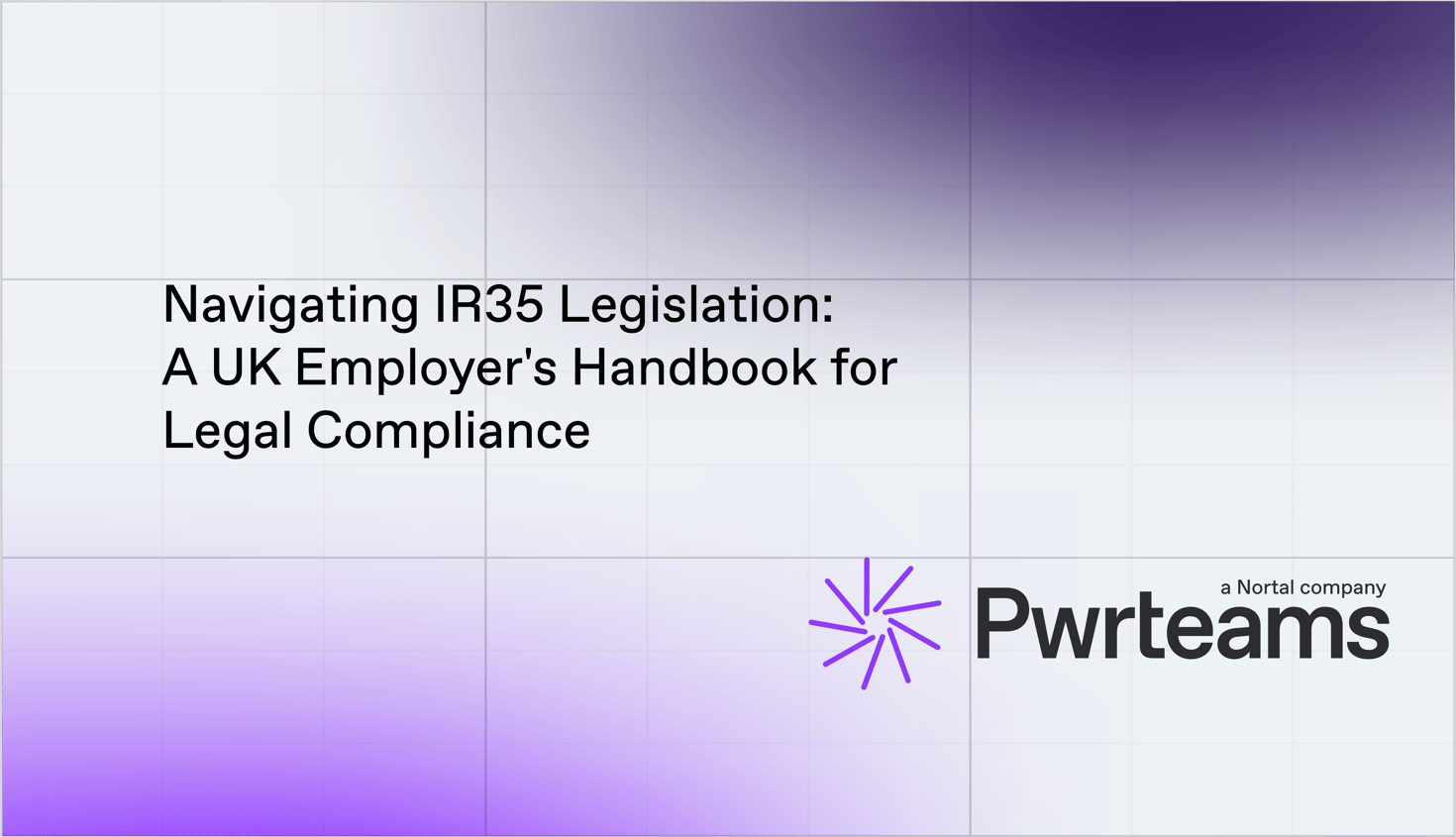Navigating IR35 Legislation: A UK Employer's Handbook for Legal Compliance


If your business employs independent contractors or freelancers in the UK, you are probably familiar with IR35 legislation. Its introduction has changed the employer-employee dynamics entirely and heavily affected taxation in Britain. With new amendments tightening the screws on off-payroll working, employers find themselves navigating even a bigger minefield of compliance issues and financial risks than when the legislation first appeared.
But how can you, as an employer, live peacefully with IR35 legislation, tapping the benefits of external hiring while keeping your revenues—and compliance—untouched? Our article will answer this and some related questions around IR35, and provide clear guidance through its complicated rules.
IR35 Legislation Dictionary
Here are a few legal terms explanations to make this read smooth and easier to digest:
- Disguised employee - A contractor who behaves more like an employee, often working exclusively for one client and lacking autonomy.
- End client - The organization for whom the contractor provides services.
- Fee-payer - The business or agency responsible for paying the contractor.
- Substitution - Contractor's ability to send a qualified substitute to do the job, indicating genuine business operations.
- HMRC - Stands for His Majesty's Revenue and Customs. Think of them as the UK's version of the IRS (US), Belastingdienst (Netherlands), FOD Financiën (Belgium).
- CEST tool - An online questionnaire by HMRC to determine IR35 status. While widely used, it can give incorrect answers.
What Is IR35 Legislation?
IR35 legislation can be complex for employers, especially with recent updates. Understanding these changes is vital for them, however, because they are now liable for compliance and accountable if something’s not right.
Named after the Inland Revenue press release, IR35 legislation is an anti-avoidance tax law enforced by His Majesty's Revenue and Customs (HMRC). It was introduced back in 2000 in the UK, to tackle tax imbalances between contractors and employees doing similar jobs.
The world before IR35…
Pre-IR35, a surge in contractors using personal, limited companies for tax benefits raised eyebrows. While not illegal, many saw it as exploiting tax rules, letting contractors operating through personal, limited companies enjoy employee perks without the tax burden. Consequently, the legislation targeted "disguised employment," where contractors behaved like employees to reap tax benefits, enabling employers to trim expenses linked with formal employment contracts.
…and after
By 2017, a significant overhaul occurred with the introduction of new 'off-payroll working' rules. They initially affected public sector contractors, shifting the responsibility for determining the status of engagements to the end clients. Following a delay due to the COVID pandemic, the rules were extended to include the private sector in 2021.
The reforms introduced the concept of the fee-payer, which is usually the contractor's end client, responsible for ensuring that taxes such as Income Tax, National Insurance Contributions (NICs), and the apprenticeship levy are appropriately deducted from the contractor's earnings. The recent changes as of April 6th, 2024, ensure that legal accountability is shared between the fee-payer and the contractor, lightening the tax load on deemed employers.
As of February 2024, there were over 4 million self-employed workers in the UK, including contractors, freelancers, self-employed consultants, and independent agency workers. Many of them have experienced the impact of IR35 legislation in various ways. Despite the efforts to simplify the regulations, many employers remain puzzled by the ongoing changes and shift back toward payroll work to sidestep the complexities of compliance.

Why Is IR35 Legislation Controversial?
IR35 legislation sparked controversy, leaving employers grappling with navigating legal complexities effectively.
In essence, IR35 requires businesses to determine if a contractor resembles a self-employed worker or an employee. While on the surface it may seem simple, the rules are anything but clear, leaving many puzzled over 'inside' or 'outside' IR35 status.
Put yourself in the employer's shoes. You must assess if your contractor falls under IR35, with serious financial repercussions for errors. According to a survey by Qdos, only 63.6% of businesses have the necessary processes to manage off-payroll working rules compliantly. No wonder many err on the side of caution, and label everyone 'inside IR35' just to avoid any potential trouble.
However, there's a downside to this approach: playing it safe could result in overlooking top talent. Indeed, numerous skilled workers prefer operating outside IR35 for a multitude of reasons. By exclusively selecting 'IR35 insiders,' businesses risk isolating themselves from a vast pool of experienced specialists whose contributions could greatly enhance project delivery speed and quality.
Inside vs. Outside IR35 Contracts
Inside and outside IR35 contracts represent two classifications, determining whether the off-payroll rules apply to a contracted worker. Here's the lowdown on when contracts fall under the legislation:
- Worker's Arrangement: Contracts under IR35 entail workers providing services through intermediaries such as a limited company, partnership, or individual.
- Taxation: Contractors are treated like employees of the client for tax purposes.
- Payment Handling: The fee-payer, whether the client, an agency, or another entity, is responsible for deducting income tax and NICs (National Insurance Contributions).
| Criteria | Inside | Outside |
|
Control |
The client dictates how, when, and which duties the individual performs. |
The individual has control over their work constraints. |
|
Personal Service |
The client does not allow the substitution of responsibilities to another individual. |
The individual can substitute for someone else to complete the work. |
|
Mutuality of Obligation |
There's an obligation for the individual to offer services and for the client to accept them. |
The individual has the right to refuse work. |
|
Financial Risk |
The majority of financial risk lies with the client. |
The individual bears significant financial risk in their work. |
|
Exclusivity |
The individual works exclusively for one client, with frequent contract renewals. |
The individual works for multiple clients simultaneously, with less frequent contract renewals. |
|
Payment |
Payments are often fixed hourly/daily rates. |
Payments are usually based on completed jobs rather than fixed rates. |
How Does IR35 Legislation Affect Employers?
When you search for "IR35 legislation" on Google, you'll find numerous articles guiding independent contractors on compliance. However, there's a noticeable lack of resources addressing the employer's viewpoint. That's precisely why we're delving into the benefits, responsibilities, and legal implications that directly impact employers.
Benefits
- Engaging contractors compliantly outside IR35 alleviates employers from PAYE (Pay As You Earn) tax obligations.
- National Insurance contributions (NICs) savings can be significant, especially for short-term projects where hiring a fixed-term employee might not be feasible.
- Employers are not responsible for providing employment benefits such as sick pay, annual leave entitlements, and other employee benefits when engaging contractors outside IR35.
Risks and Responsibilities
- With the changes in off-payroll working, employers are now responsible for assessing contractors' IR35 status.
- Employers must now ensure that the correct tax and National Insurance contributions are deducted from the contractor's earnings.
- Failure to comply with IR35 legislation can lead to reputational damage for employers.
- Employers must be prepared to manage these risks and ensure accurate IR35 determinations to retain valuable talent and safeguard their reputation.
The Legal Implications of Misclassifying Workers
- Financial Penalties: The misclassification of contractors under IR35 legislation can result in penalties for employers, including fines, interest on unpaid taxes, and potential legal costs associated with resolving the issue.
- Back Taxes and NICs: If HMRC determines that a worker has been incorrectly classified and should have been treated as an employee for tax purposes, the employer may be required to pay back taxes and NICs that should have been deducted from the worker's earnings.
- Legal Action: Workers who have been miscategorized may sue their employers to recover any unpaid taxes, NICs, and potential damages for loss of employment rights and benefits.
- Contractual Disputes: Misclassification can also lead to contractual disputes between employers, workers, and any intermediary agencies involved in the engagement. Disputes may arise regarding the terms of engagement, liability for unpaid taxes, and responsibilities for resolving the issue.
Off-Payroll Working Reduction
The IR35 legislation has led to a significant decline in individuals operating through Personal Service Companies (PSCs), with 100,000-150,000 people transitioning to payroll employment. This shift reflects the reform’s impact on the flexibility of the labor market, as workers seek the security and simplicity offered by traditional payroll arrangements.
Fearing misclassification and potential penalties, many companies opt to reduce contractor hiring and instead choose payroll employment. This shift minimizes non-compliance risk, as tax and National Insurance contributions are deducted at source, providing companies with greater peace of mind.
Finding the Work Arrangement Balance
Giving up on potentially top-tier talent in favor of administrative ease and legal adherence might suit some businesses, but we understand you’re seeking a balance. Experimenting with alternative work setups offers benefits like flexible staffing and streamlined payroll operations. However, navigating this path isn't always easy. That's where our recruitment experts step in.
How can they help you comply with IR35 legislation without compromising on your team’s potential? We’ll delve into that in the follow-up article, exploring strategic workforce planning to help you establish a well-rounded workplace structure. While you wait, you can contact us directly to discuss personalized hiring options for your business. Until then!
 September 29, 2025
September 29, 2025
Build your team or extend with ours? Here’s what helps fintech CTOs decide
Read the post September 10, 2025
September 10, 2025
Fixed-price projects vs dedicated teams: A fintech CTO comparison
Read the post September 3, 2025
September 3, 2025
How burnout is crippling tech leadership in the Nordics and Benelux
Read the post September 29, 2025
September 29, 2025
Build your team or extend with ours? Here’s what helps fintech CTOs decide
Read the post September 10, 2025
September 10, 2025
Fixed-price projects vs dedicated teams: A fintech CTO comparison
Read the post September 3, 2025
September 3, 2025
How burnout is crippling tech leadership in the Nordics and Benelux
Read the postWrite your own
success story
with Pwrteams!
Share your details in the form, tell us about your needs, and we'll get back with the next steps.
- Build a stable team with a 95.7% retention rate.
- Boost project agility and scalability with quality intact.
- Forget lock-ins, exit fees, or volume commitments.